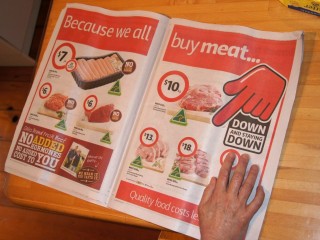 Is it another supermarket price war, or simply reflective of seasonal supply and demand patterns?
Is it another supermarket price war, or simply reflective of seasonal supply and demand patterns?
Opinion is sharply divided over latest moves by supermarket giants Coles and Woolworths, which last week savagely lowered prices on legs and other popular lamb items.
An all-out price war erupted between the two last December when both lowered prices on a wide range of beef items, in an attempt to win market share. None of those items have shifted much in price since, under both company’s ‘prices are down and staying down’ policy.
Milk and other staples have since been added to the price war, and last week’s developments suggest lamb may be the new battleground in the chilled cabinet.
Both supermarket groups dramatically lowered prices on legs of lamb late last week. Full page advertisements in metropolitan newspapers again today suggest the discounting is extending into other popular lamb items. Some loin cuts were discounted 28pc in a Coles ad this morning
In a recent article “Woolworths regains top dog status in retail pecking order” Beef Central pointed out that lamb retail prices have risen 10pc over the past 12 months and 25pc over three years, going past beef as the most expensive protein option for the first time in June, according to Roy Morgan research data.
That trend has in turn impacted on lamb consumption, which in July was close to slipping below 20 million serves nationally each week, in contrast to beef on 53 million.
The Australian Meat Industry Council’s national retail committee chairman, Kerry Melrose sees last week’s development as an ‘outright price war.’
“Despite heavier spring supply, carcase lamb wholesale prices have not dropped – they’re currently $6 to $6/50.kg into the butchers. There has been no substantial drop in wholesale market prices to warrant the corporate retailers dropping the retail price of lamb legs by $5/kg. It is absolutely nothing other than a price war,” Mr Melrose said.
He suggested legs were now retailing in Coles/Woolworths at $8.99/kg, down from $13.99-$14.99/kg earlier.
“To buy lamb legs off a wholesaler, you would be paying around $7.50/kg, so the supermarkets are very nearly selling them at cost,” Mr Melrose said.
While there was a flush of Victorian spring lamb around (Tasmanian supplies are traditionally a few weeks later) these were still ‘quite expensive.’
“There has not been any flood of lamb evident in the market that warrants dropping the price as the supermarkets have,” he said.
At their peak, wholesale carcase lamb prices had reached about $7.50/kg. While they had come back about $1- $1.50/kg off that, prices were still historically ‘pretty high.’
“At these retail prices, both for lamb and beef, supermarkets are very, very competitive and are making life particularly hard for independent retail butchers,” Mr Melrose said.
Asked what a ‘realistic’ retail price would be, given ongoing costs through to retail, he said lamb legs should currently be $13-$15/kg to reflect the true costs involved.
“It’s about growing market share, like petrol, where the supermarkets have come from nowhere to controlling 60pc of the market,” he said.
But not all industry stakeholders have interpreted latest move by the majors as a lamb price gun-fight.
“I don’t see it as a war yet, so much as a seasonal price adjustment,” said one reliable independent source, who because he is close to both companies, asked not to be named.
“There is a normal surge in supply occurring with the start of spring lamb turnoff, and this is nothing more than a spring lamb promotion. They do it every year – in fact the entire industry does it,” he said. “It’s not unusual – it is fairly normal business for this time of year.”
Meat & Livestock Australia domestic market manager Glen Feist said there was no doubt that the supermarket fresh food price war this year was ‘knocking independent retailers around,’ and the emergence of the cold-storage warehouse retailing model was having an effect at the other end.
“When wholesale costs go up, retailers try to maintain prices as long as they can, chewing into their margins. But when they finally put their retail prices up, they run the risk of losing share. Butchers have to continue to concentrate on what else they offer the customer, apart from price, in terms of service, value-adding and other attributes.”
Asked whether widely discounted lamb would eat into beef’s domestic market share, Mr Feist said it was unlikely, as the main impact on domestic beef consumption was push-and-pull from export markets.
“But having said that, our current spring lamb campaign is going like a rocket,” he said.
The lamb campaign extends from TV ads right through to point-of-sale material, which has had some significant ‘tweaks’ this year, he said. One of those has been in making the message unique to each suburb. For example, the current ‘Lamb fashion’ message on a strip signage running along a butcher’s cabinet might say, “Milan, New York, Parramatta.”



HAVE YOUR SAY